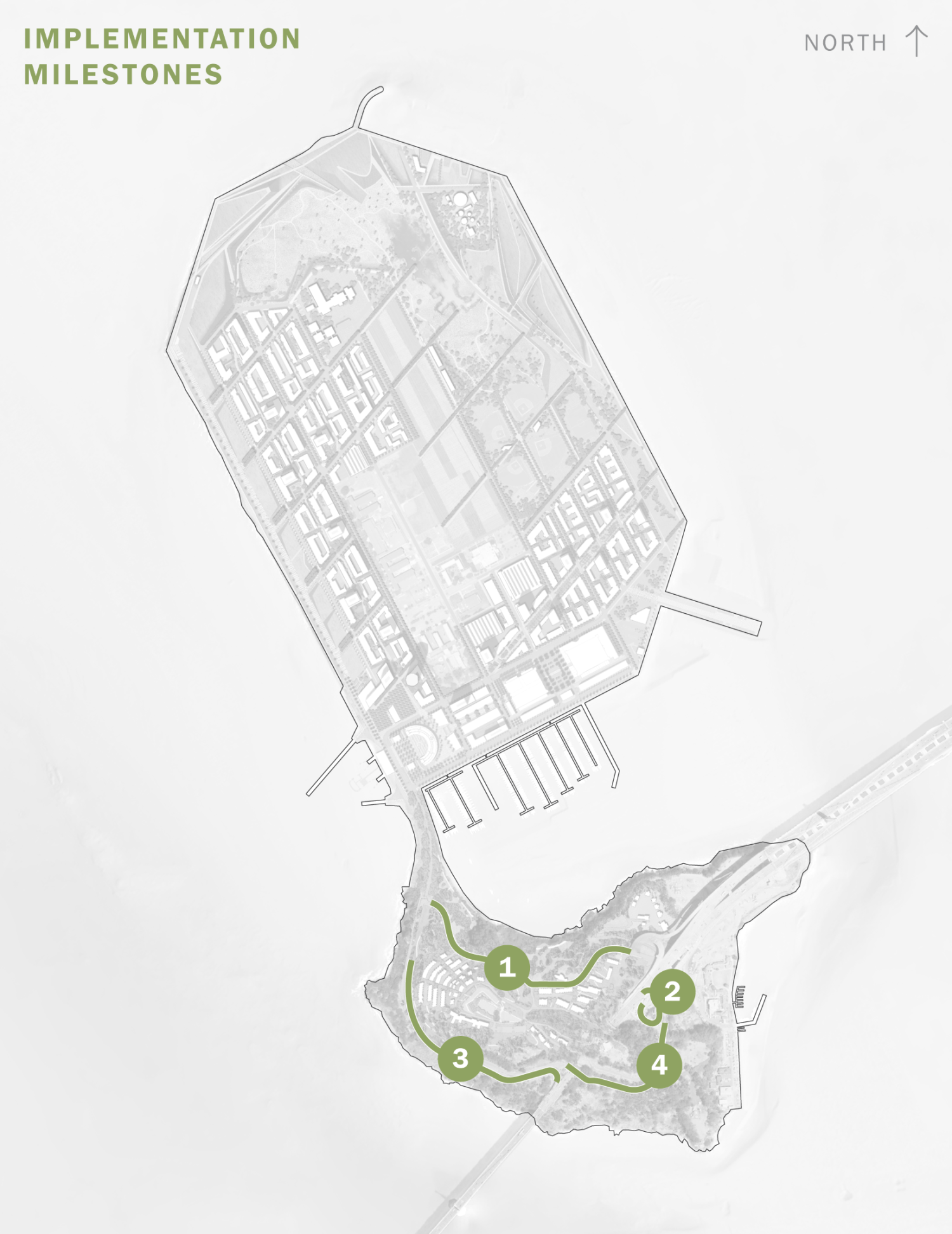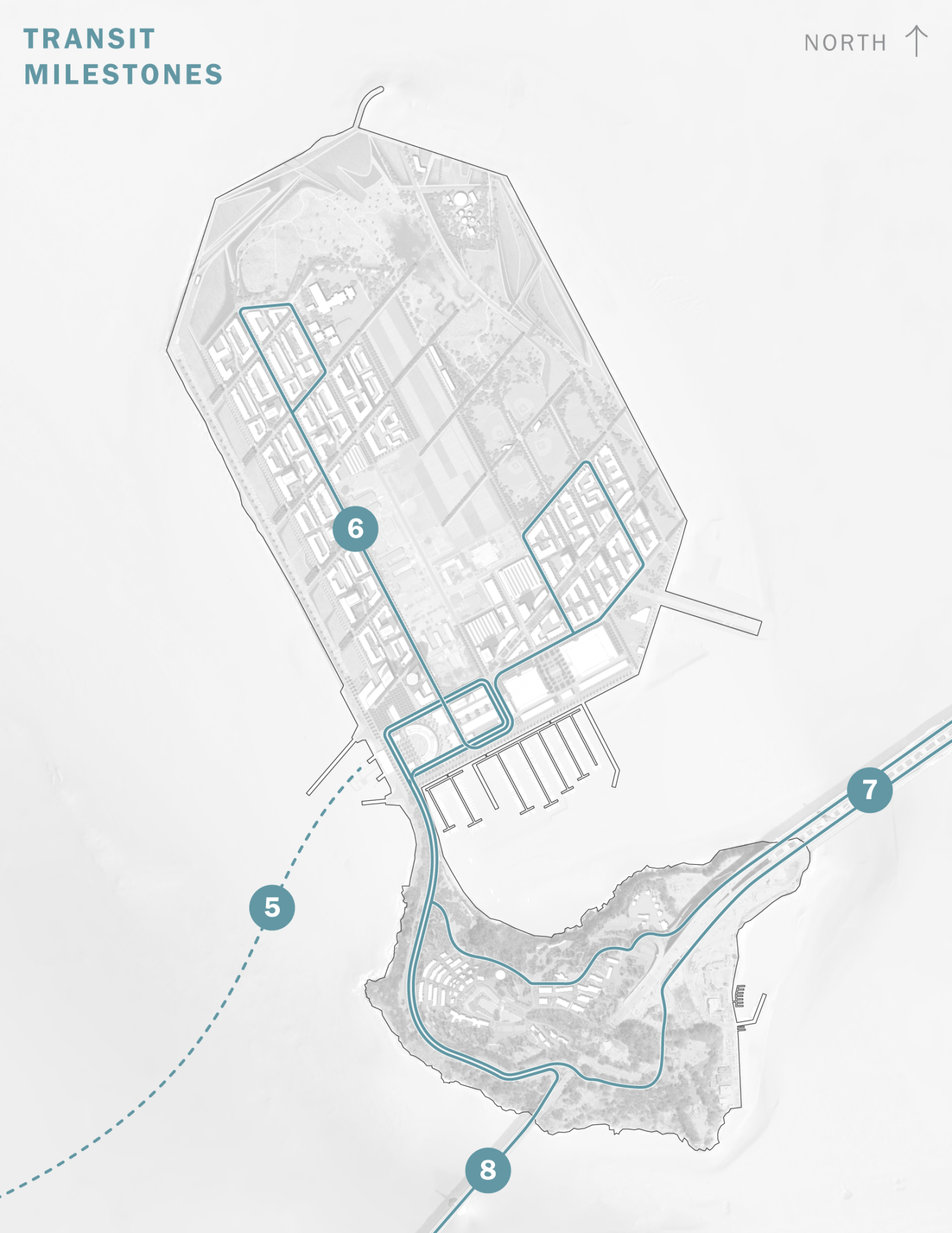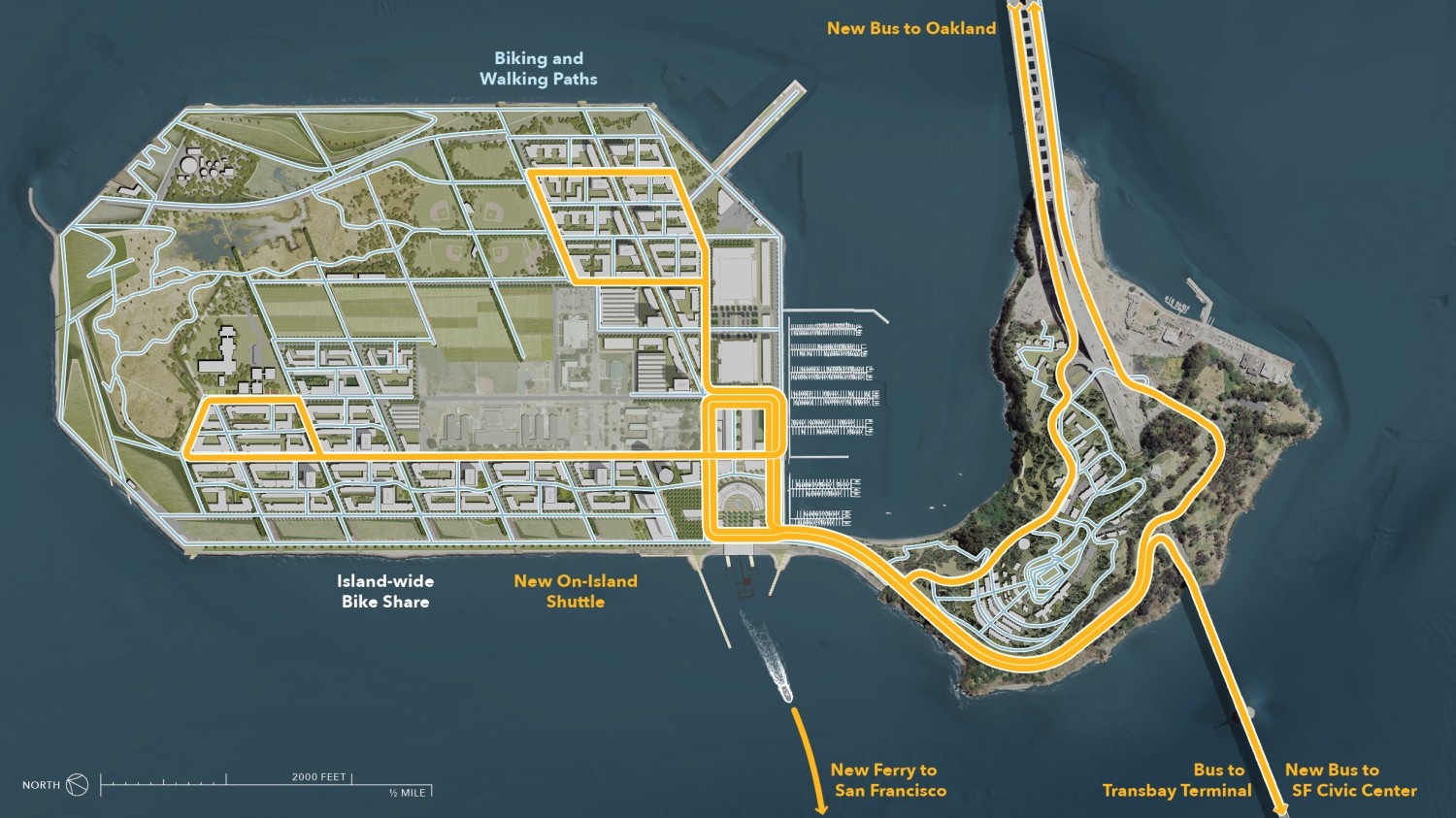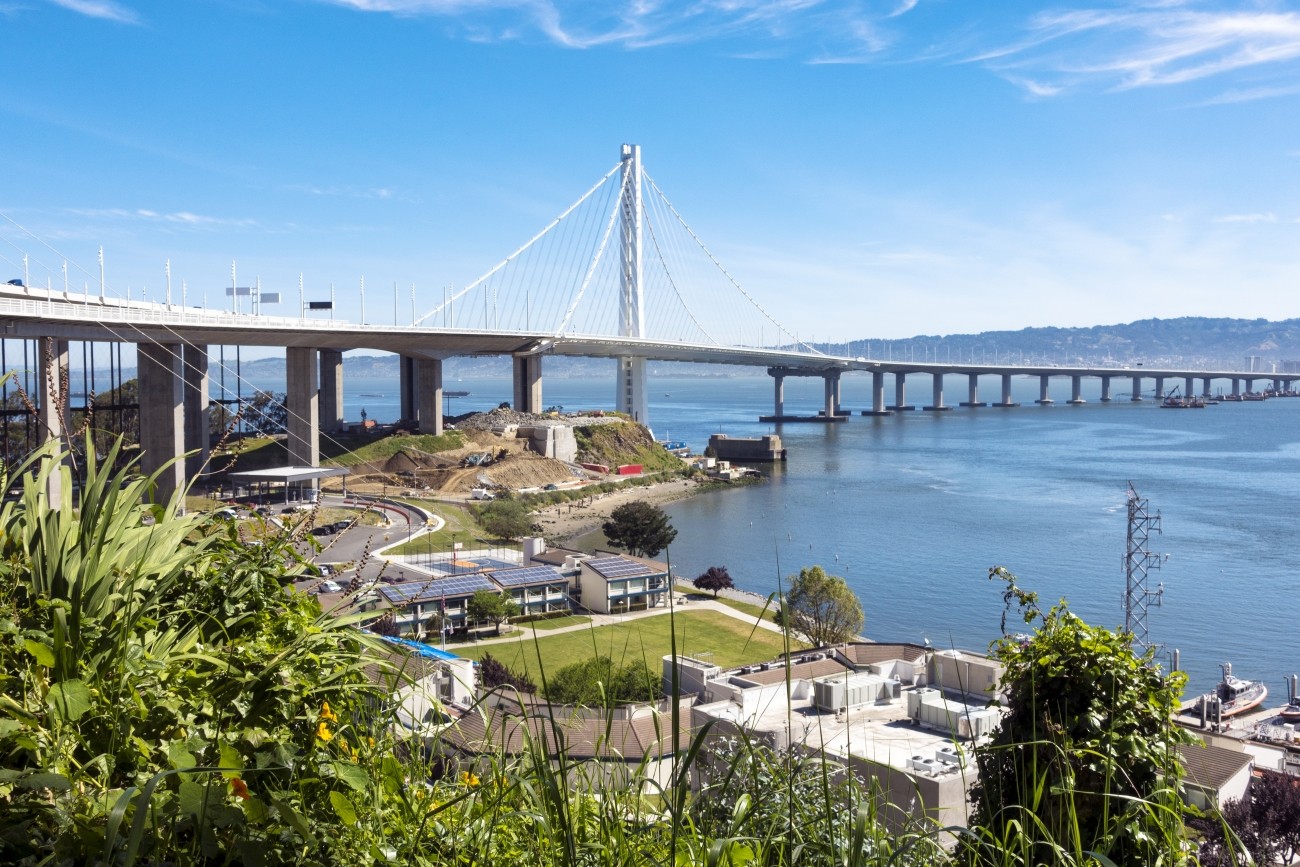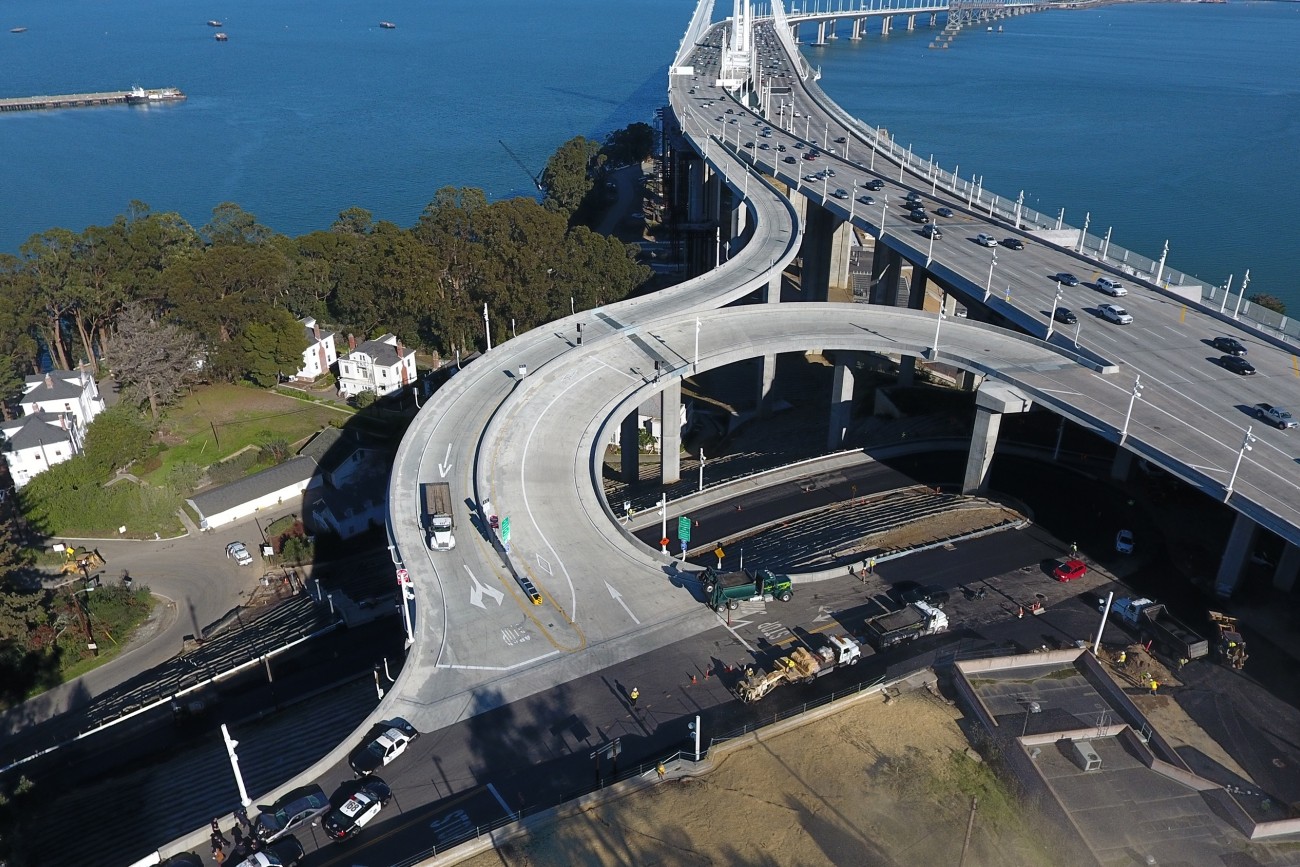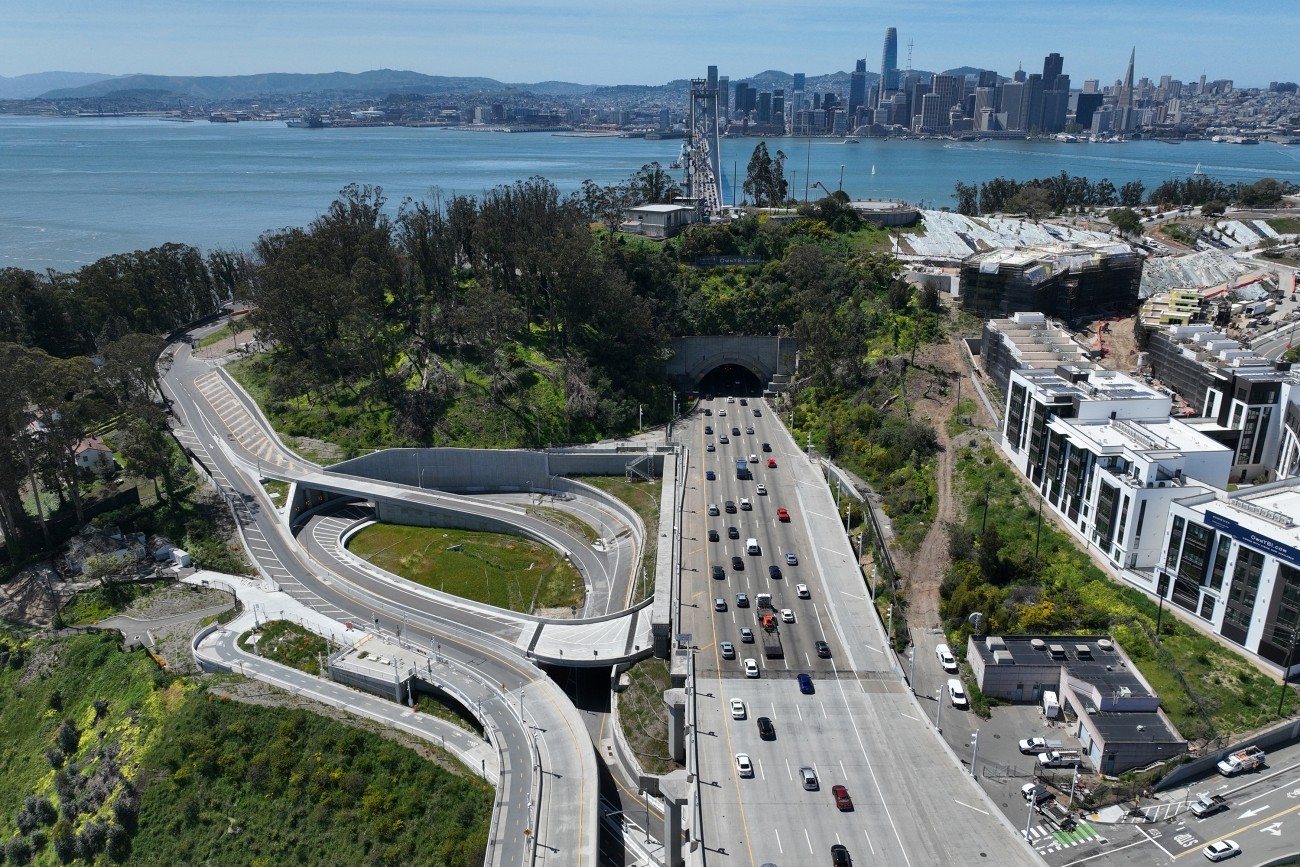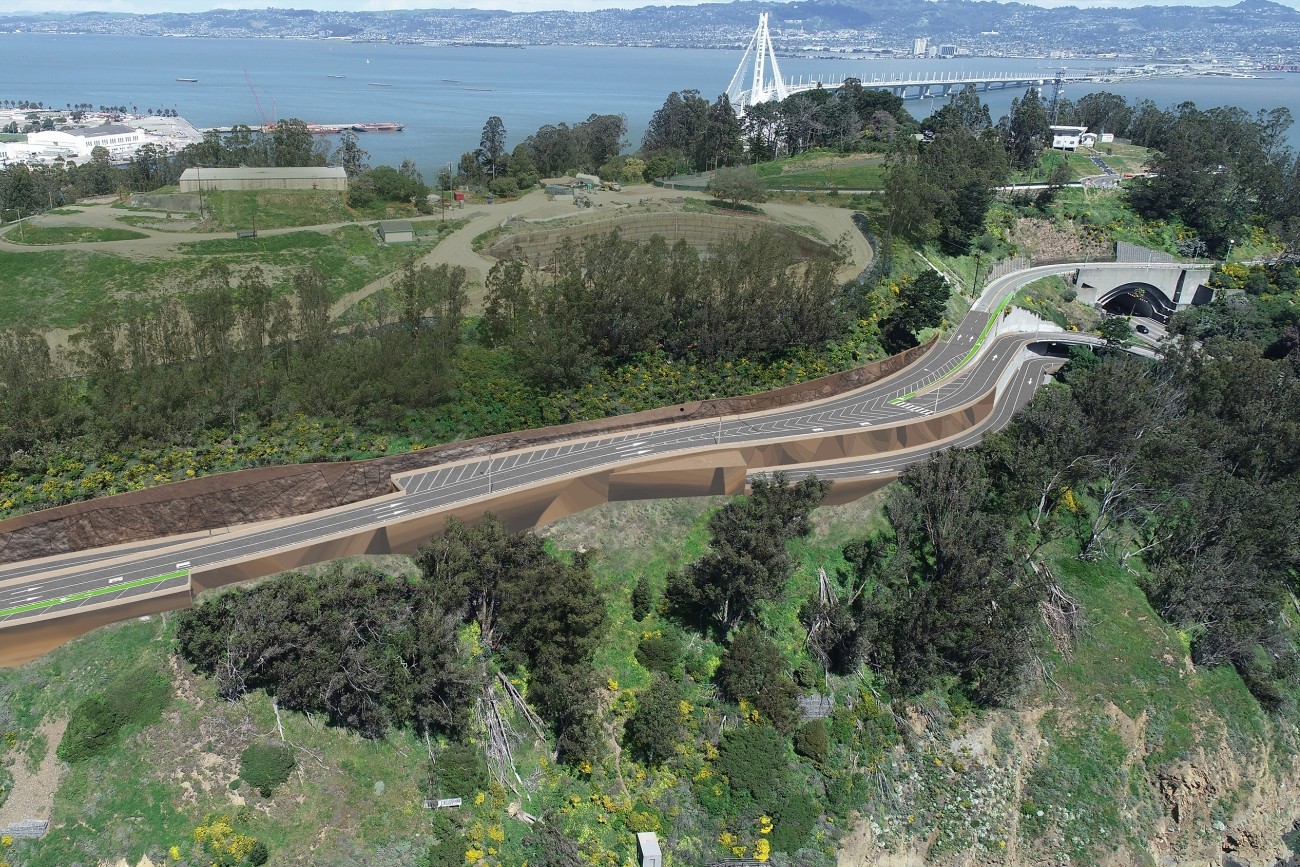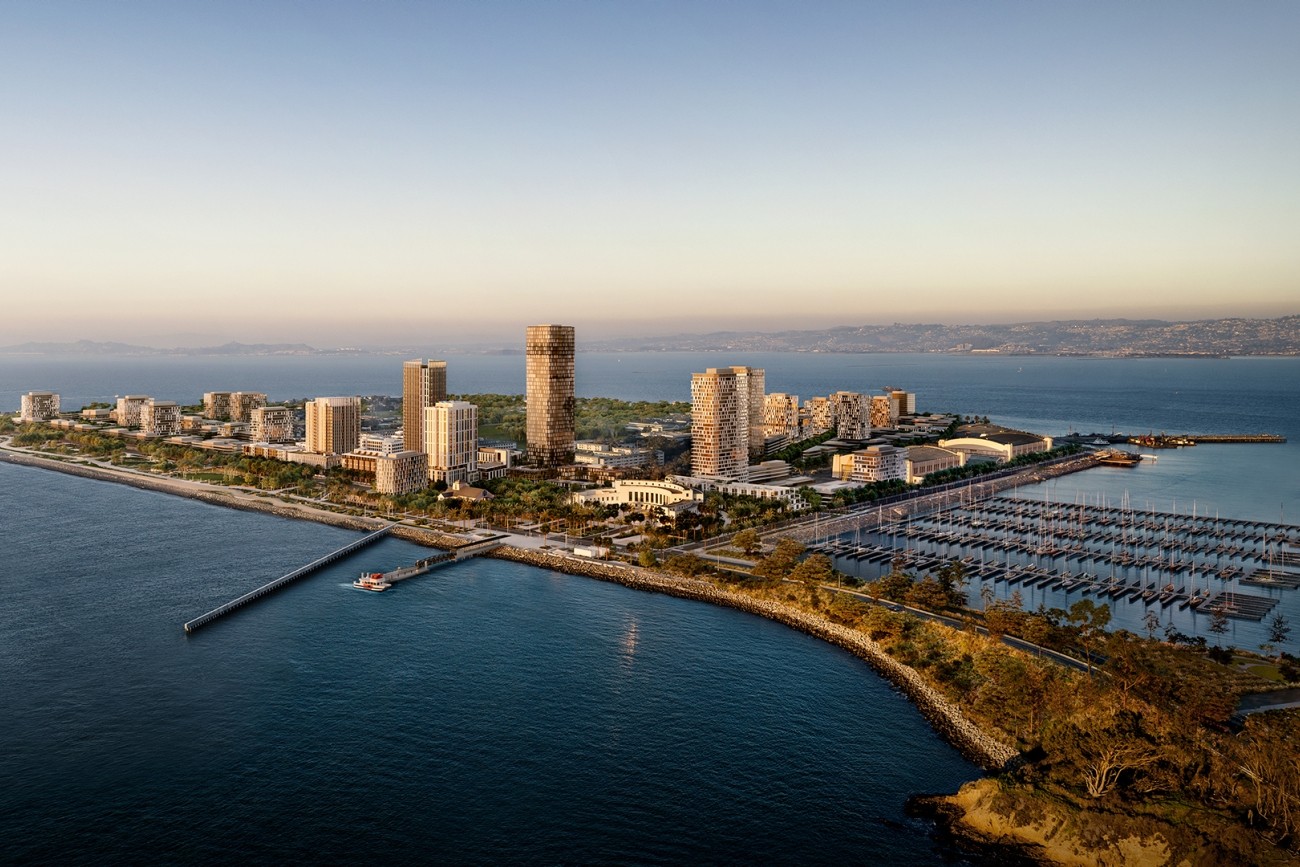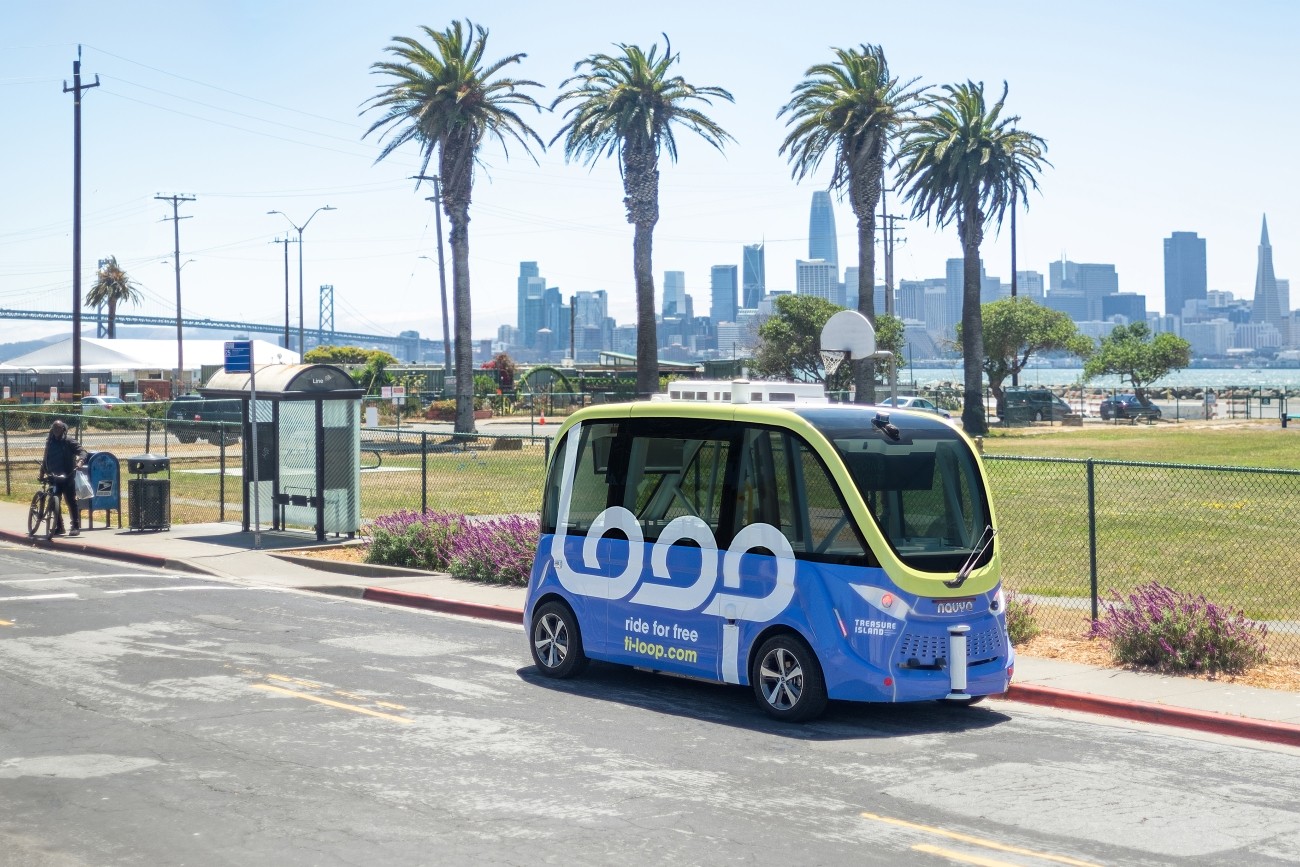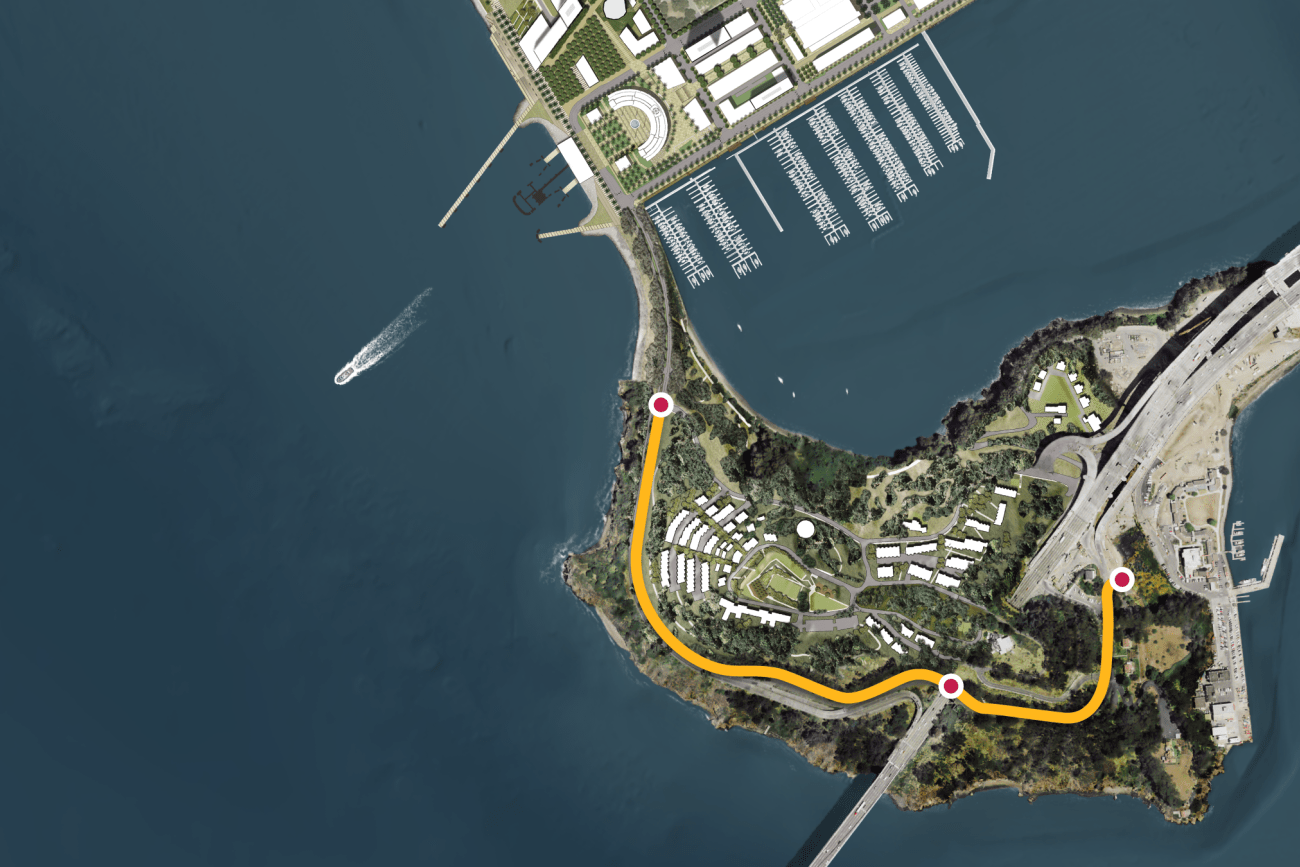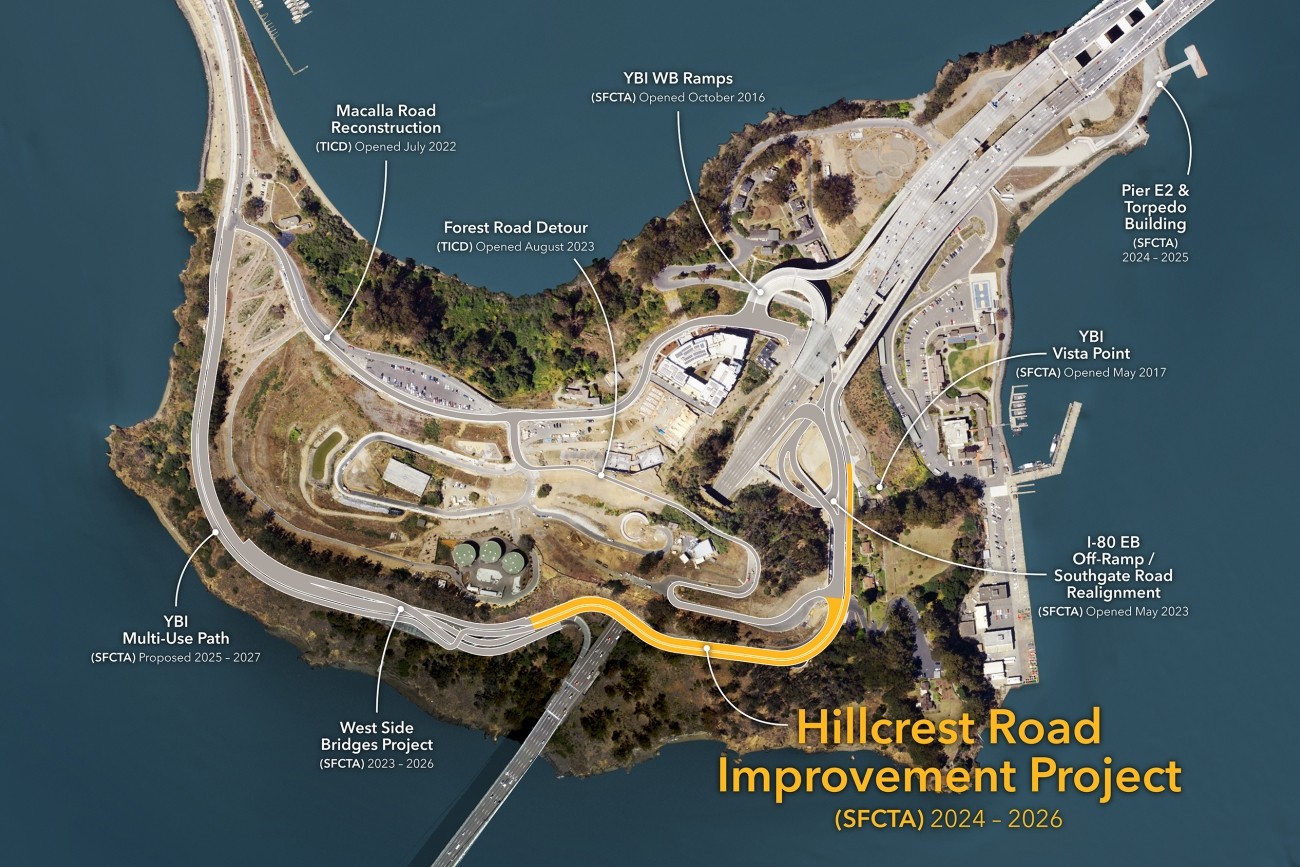
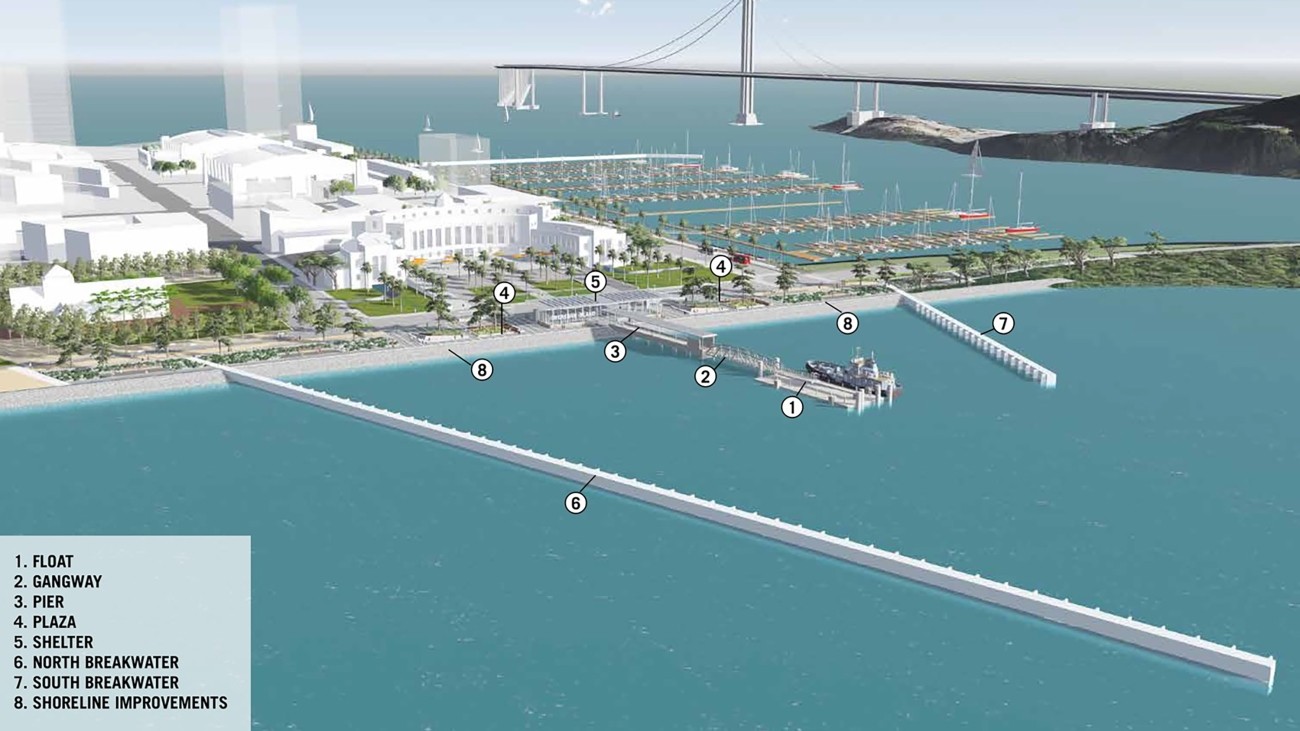
A new Treasure Island passenger dock opened in 2022, allowing interim ferry service to start between the island and downtown San Francisco.
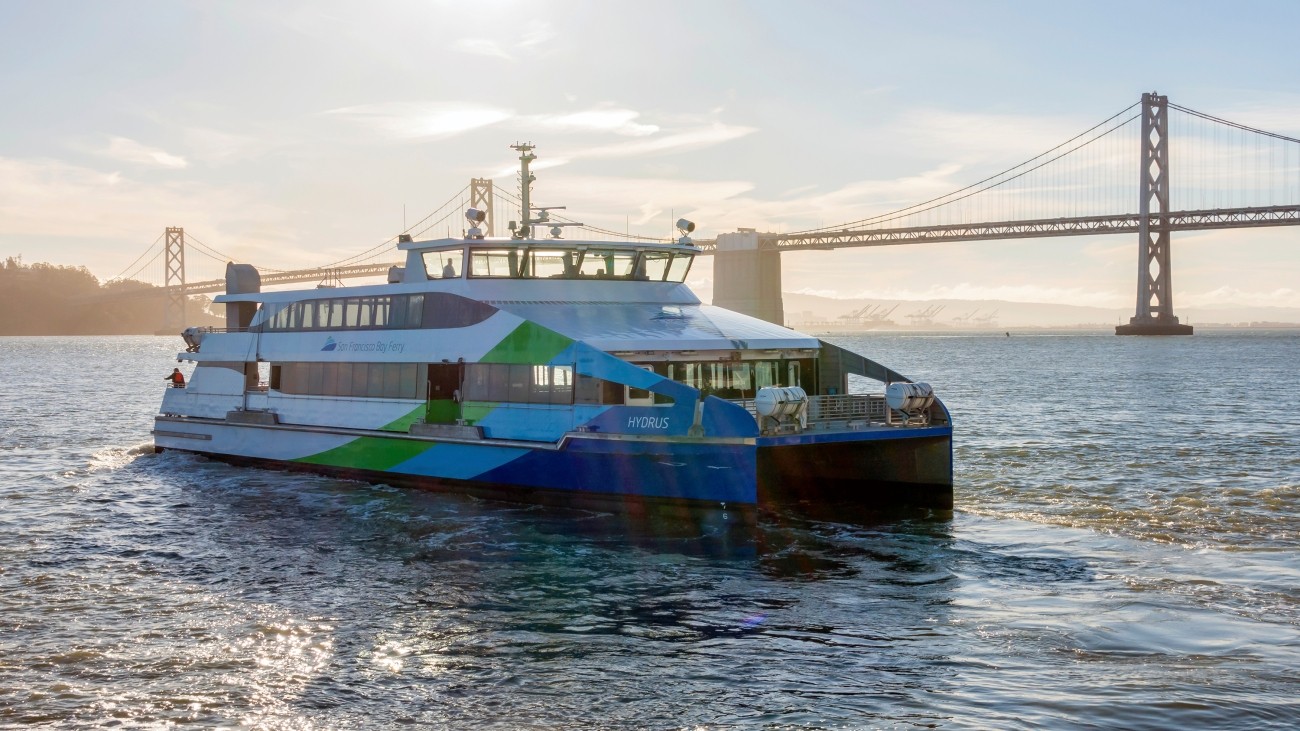
Permanent electric ferry service between Treasure Island and San Francisco will be provided by SF Bay Ferry. Photo by Sergio Ruiz
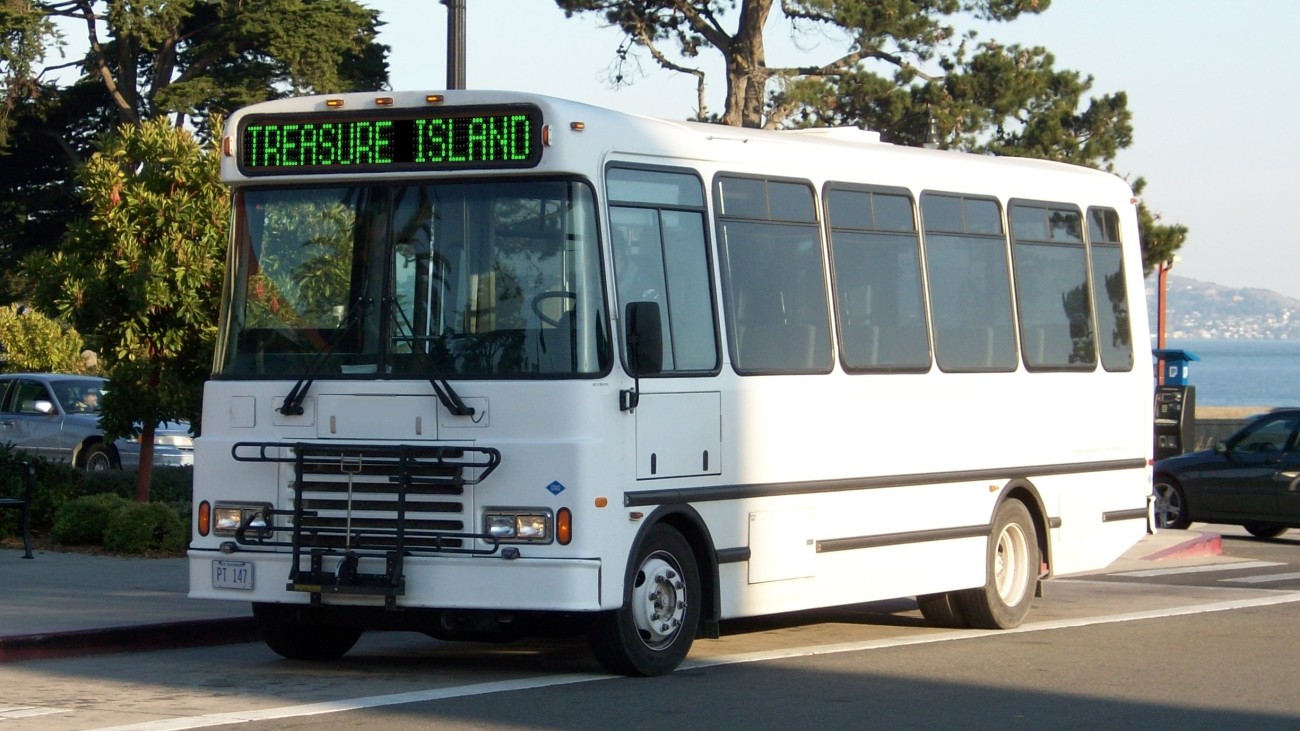
Free on-island passenger shuttle will provide a “last-mile” connection for public transit riders on Treasure Island and Yerba Buena Island.
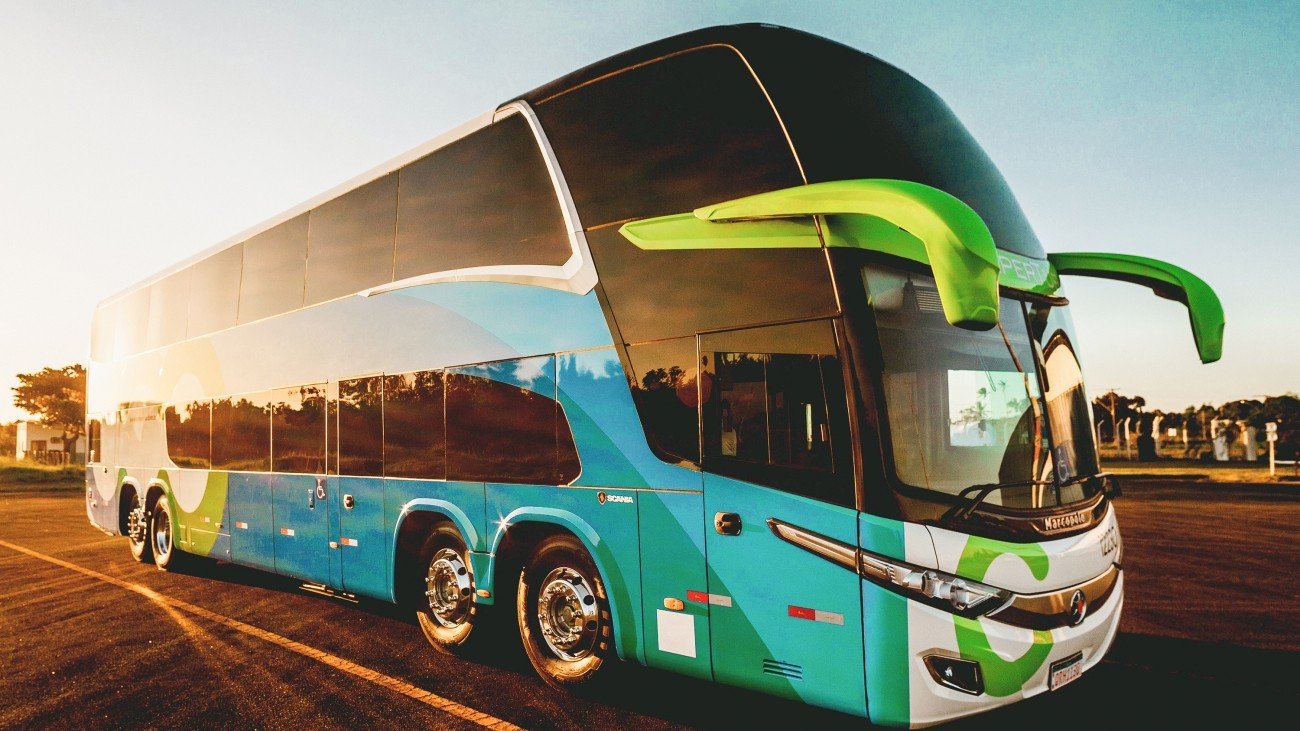
New East Bay bus service will connect Treasure Island to Oakland Civic Center. (Photo for illustrative purposes only.)
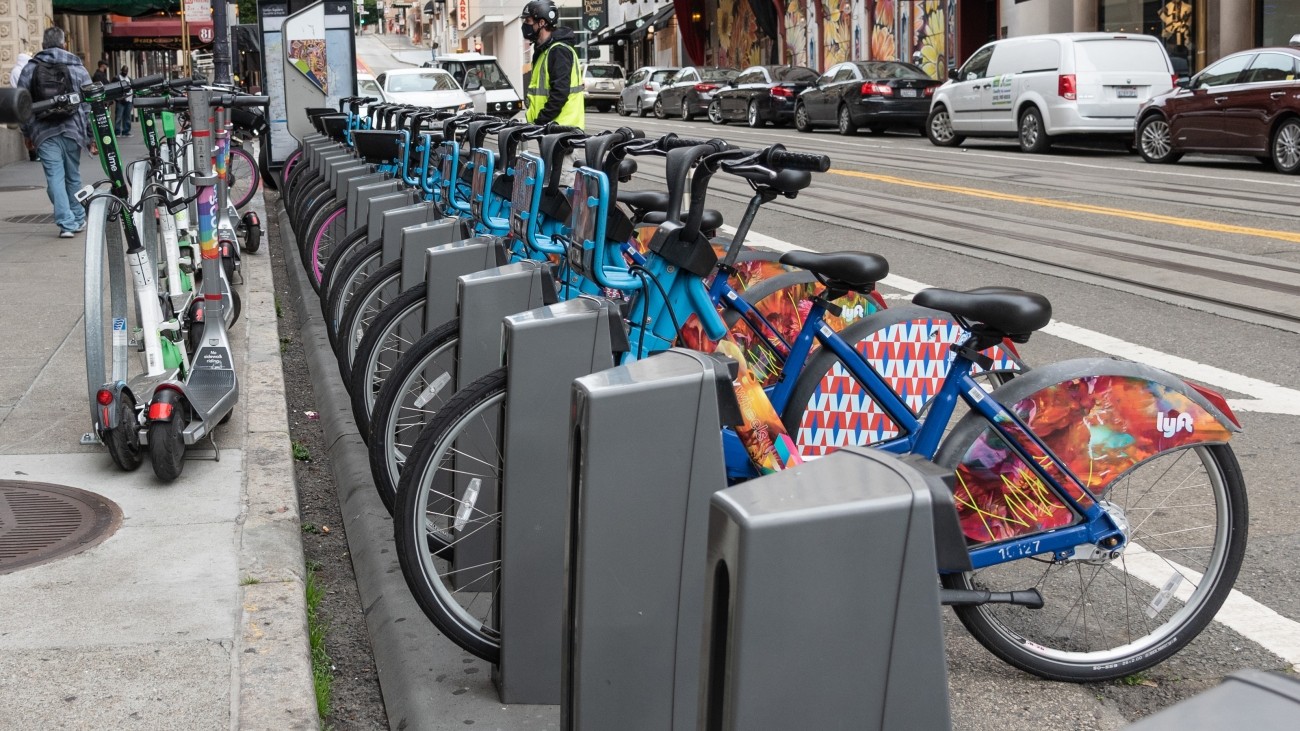
Bike share will be available for residents, visitors and workers on both Treasure Island and Yerba Buena Island. Photo by SFMTA Photography Department
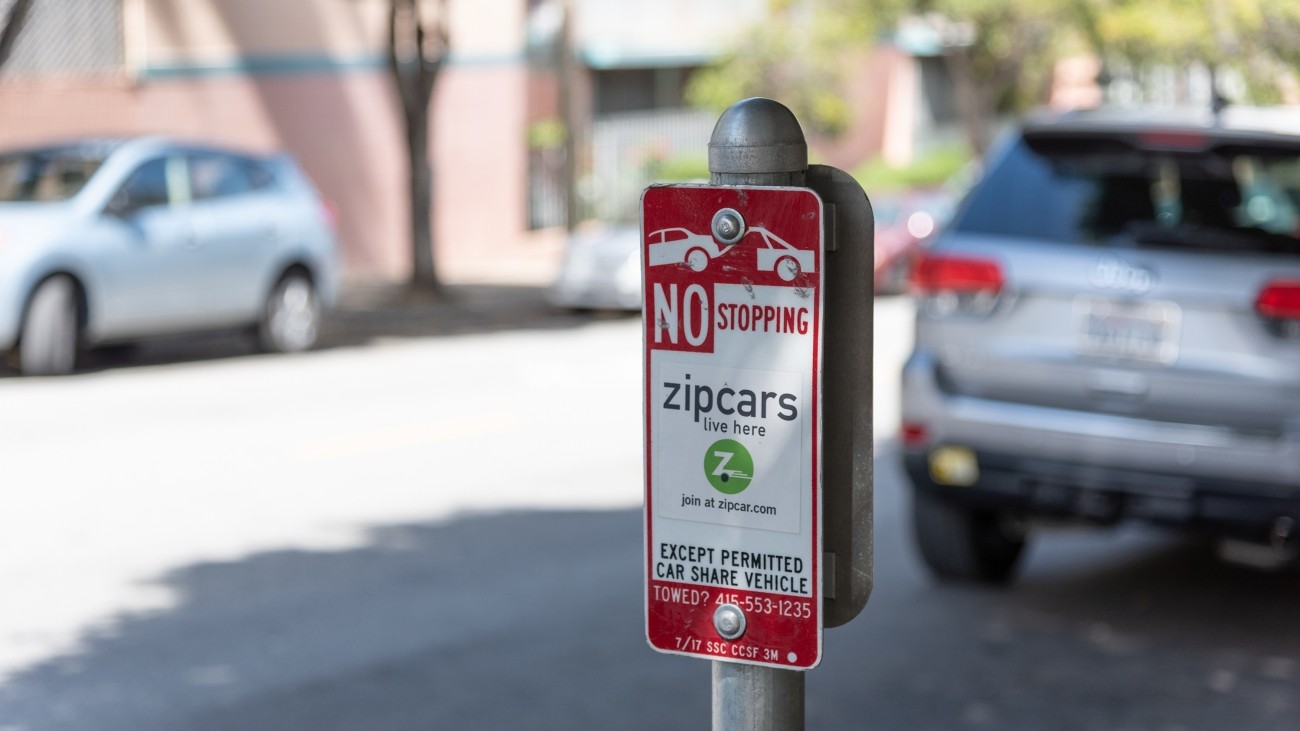
Car share and programs like carpool matching will be available on the island. Photo by SFMTA Photography Department
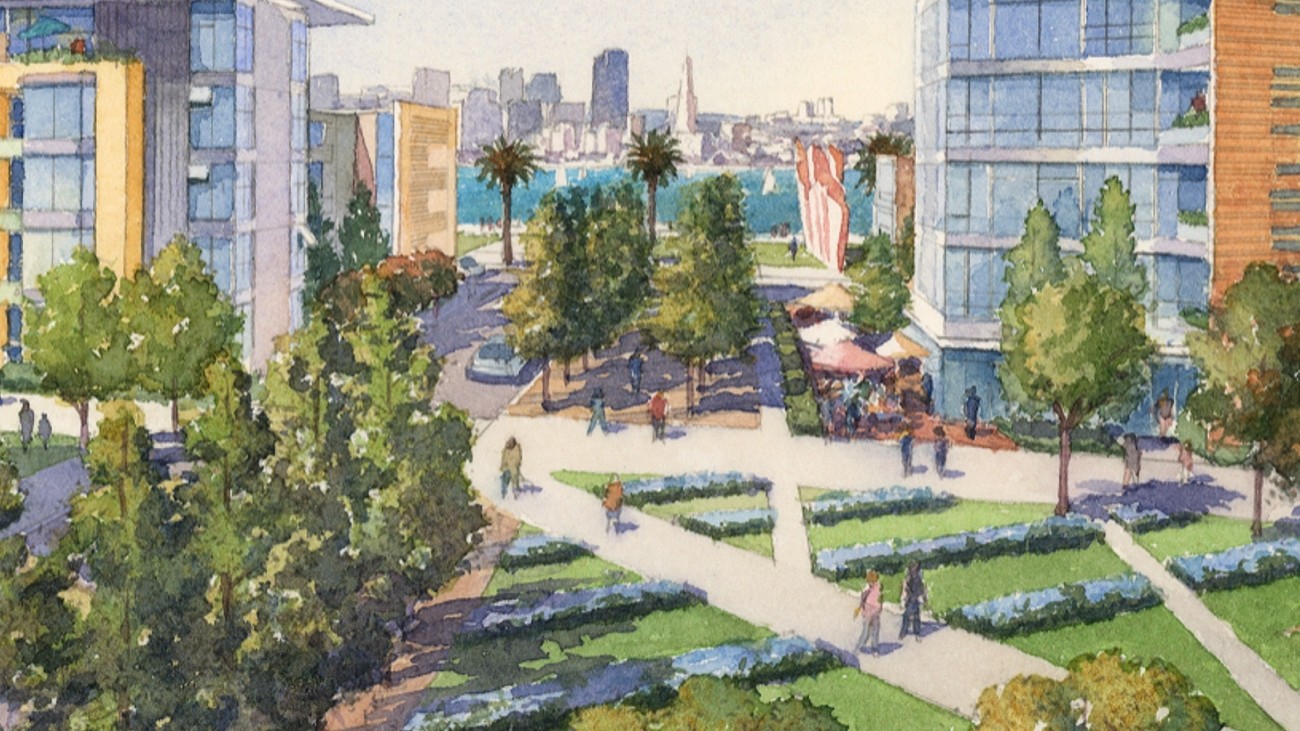
Treasure Island will feature walking paths and pedestrian-only streets, including a multi-use path for bicyclists and pedestrians that connects Yerba Buena Island and the Treasure Island ferry terminal.
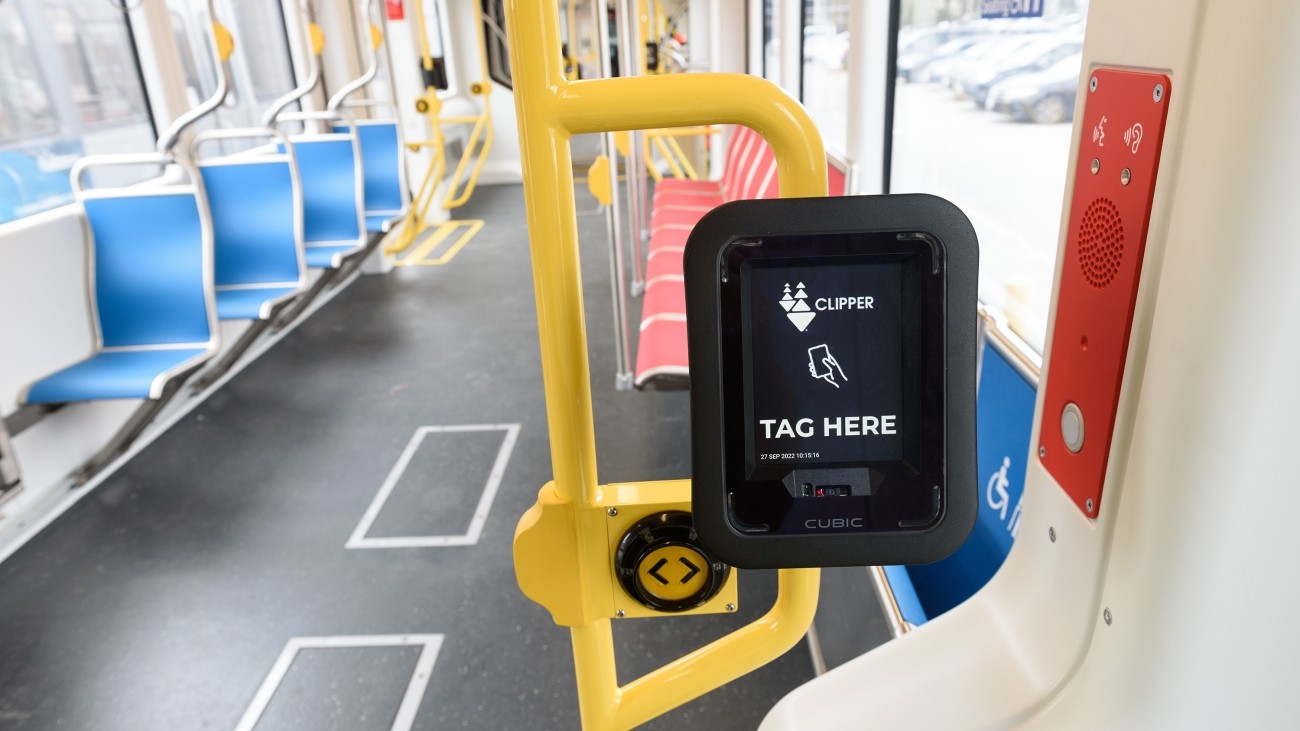
Treasure Island residents in below-market rate housing will qualify for a Clipper Card at a 50 percent discount. That pass will allow unlimited rides on all Muni, AC Transit, and the Treasure Island ferry. Treasure Island residents in market-rate housing will be required to purchase this same monthly Clipper Card at regular price. Photo by SFMTA Photography Department
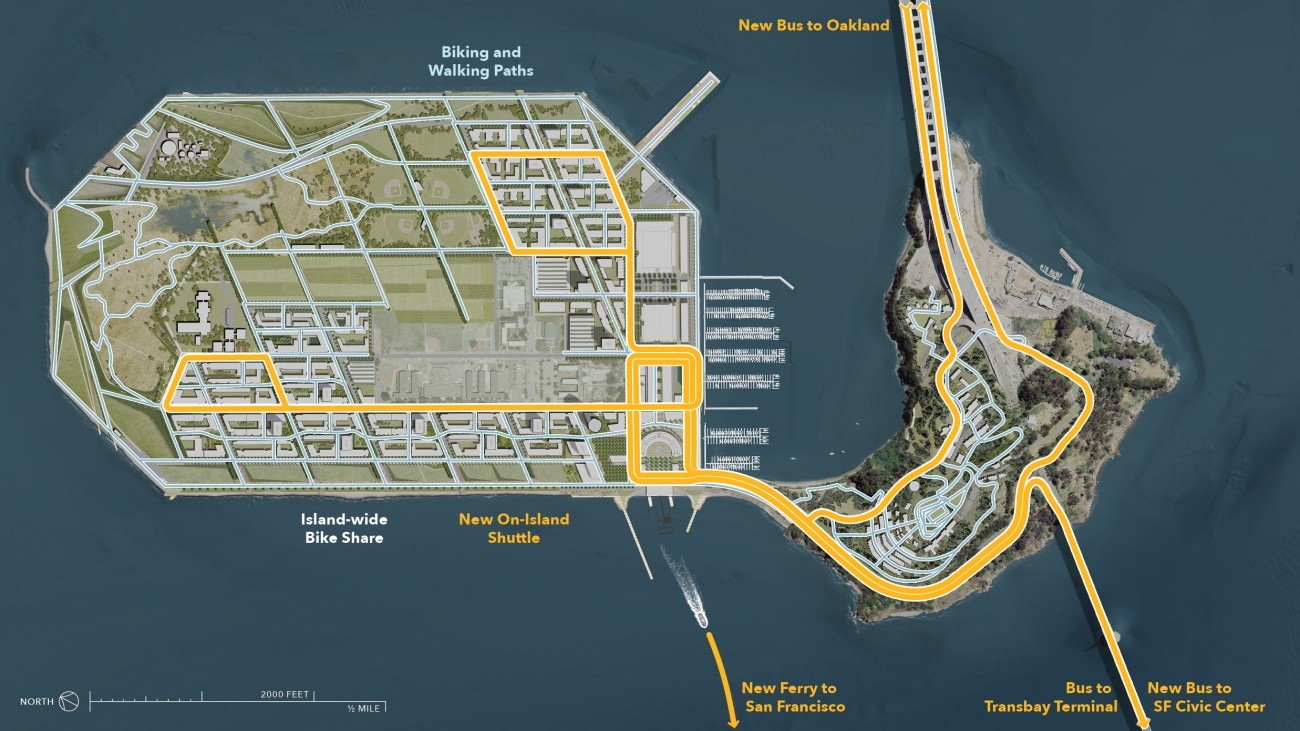
This map outlines the key transportation features of Treasure Island and Yerba Buena Island in coming years.
Treasure Island Mobility Management Agency awarded $20 million U.S. EPA Community Change Grant
The U.S. Environmental Protection Agency has awarded the Treasure Island Mobility Management Agency, or TIMMA, a $20 million grant for a collection of Treasure Island transportation improvements called Treasure Island Connects. For more information, here is the Press Release.
Transportation Program Overview
By 2042, the Treasure Island neighborhood will grow by up to 8,000 homes—many offered at below-market rates—housing more than 20,000 new residents. Along with more housing, this new development includes extensive open space, hotels, restaurants, shops, and entertainment venues.
This new activity will result in tens of thousands of additional trips to and from the island each day. The Treasure Island Mobility Management Agency is developing a comprehensive transportation program that will meet the current and future needs of residents, workers and visitors to ensure a vibrant community.
The Treasure Island Transportation Program is governed by the San Francisco Board of Supervisors in its capacity as the Treasure Island Mobility Management Agency Board.
Transportation Program Goals
The Treasure Island Transportation Program is guided by two performance goals: that at least 50% of trips are made by walking, biking, and taking transit, and that the program be financially self-sufficient. We can achieve this by:
Promoting walking and biking: Bike lanes, pedestrian paths, and Bay Wheels bike sharing will make biking and walking around the island safe and enjoyable.
Providing high-quality transit: More Muni service, along with new AC Transit, ferry service, and an on-island shuttle will help ensure that at least 50 percent of trips to and from the island are made using sustainable modes.
Reducing the need for car ownership and use: People who drive will pay a toll for driving on and off of the island. The cost of housing will not include parking, so people who own cars will pay for parking separately. Access to car share vehicles will make it easier to live without owning a personal vehicle on the island.
Promoting affordability: Subsidized transit passes and discounts to services like car and bike share will make transit affordable and accessible to longtime residents and people living in below market-rate housing.
Achieving financial sustainability: The transportation program should be financially self-sustaining when 4,500 of the 8,000 housing units have been occupied.
Estimated Timeline (subject to funding)
- Implementation Milestone
- Transit Milestone
- Residential Milestone
2006
First Transportation Plan developed, including toll
2008
State legislation authorized Treasure Island toll
2011
Treasure Island Development Agreement executed
2016
TIMMA Board approved initial toll policies
Fall 2019
Macalla Road construction began 1
Toll exemption for existing residents adopted
Summer 2020
Southgate Road Realignment construction began 2
2022
Interim Ferry Service started 5
Residents began moving into new housing
2023
Southgate eastbound off-ramp opened 2
West Side Bridges construction began 3
2025/2026 (pending funding)
Permanent Ferry service begins 5
On-island shuttle service begins 6
East Bay bus service begins 7
Transit pass program rollout
2026
West Side Bridges completed 3
2027
Macalla Road final configuration completed 1
Hillcrest Road construction completed 4
2028
Quarter buildout of Treasure Island housing (2,000 units)
Initial increases in Muni bus service 8
2033
Half buildout of Treasure Island housing (4,000 units)
Further increases in Muni bus service; ramp-up complete 8
2042
Full buildout of Treasure Island housing (8,000 units)
Timing TBD
Tolling begins
Program Partners
- Treasure Island Development Authority
- MTC
- Caltrans
- SFMTA
- WETA
- AC Transit
- US Coast Guard
Resources
Treasure Island Development Authority website
Contact
Use this form for any questions or comments you have about the Treasure Island Transportation Program, including the toll and affordability program, transit services, transit passes or parking policy. (Be sure to leave an email if you'd like a response to your question.)
Transportation Programs Under Development
Bus, Ferry, Walking, Biking, Shuttle
We are working to deliver the following public transit services, pending funding:
- New ferry service between Treasure Island and San Francisco: A new ferry route between Treasure Island and the San Francisco Ferry Building will operate seven days/week at least hourly from about 6:00 a.m. to 7:00 p.m. (hours and frequency to be determined, pending funding). SF Bay Ferry will operate this service with a new electric vessel.
- Interim ferry service subsidized by Treasure Island Community Development began operations March 1, 2022. (Information about interim ferry.)
- Free on-island passenger shuttle: A free on-Island shuttle will provide a “last-mile” connection for transit riders. The shuttles will serve Treasure Island and Yerba Buena Island, connecting open spaces, retail commercial zones, and residential neighborhoods. Initially, this shuttle service may be combined with East Bay bus service to serve lower demand levels more cost-effectively.
- New East Bay bus service: A new direct bus service will connect Treasure Island to Oakland Civic Center. During the initial years of the program, the East Bay route will likely operate as an on-demand micro transit service, seven days/week with maximum wait times of 15 minutes.
- Bike share: Bay Wheels bike sharing stations will be available for residents, visitors and workers on both Treasure Island and Yerba Buena Island.
- Car share and programs like carpool matching: A carshare provider will offer their services on-island. Carshare members will have the ability to check out vehicles for use, making payments based on the total duration of the check-out period and/or the distance driven.
- Walking paths and pedestrian-only streets: Pedestrian/bike paths are being constructed with general development of the Islands. A multi-use path for bicyclists and pedestrians connecting Vista Point on Yerba Buena Island to the Treasure Island ferry terminal will be constructed as funding is secured.
Toll and Affordability Program
The toll will help manage congestion and help pay for expanded transit service and other transportation improvements.
Treasure Island residents: The TIMMA Board decided in 2019 that existing Treasure Island residents will not pay the toll. This toll exemption means Treasure Island residents will be able to drive on or off the island any number of times at any time of day and they will not pay the toll. Read the resolution approving a toll exemption for current Treasure Island residents (PDF).
Treasure Island businesses/workers: In 2021, the TIMMA Board approved an affordability program for current businesses and workers on Treasure Island with the following elements:
- Applies to all existing not-for-profit entities and existing food distribution and food service establishments
- Employers are provided a quarterly subsidy based on number of employees
- Employers should prioritize compensation for low-income employees
- Remaining balance may be used to compensate deliveries, vendors, visitors, and/or customers
- Employers may use the subsidy to add to a toll tag (FasTrak) balance or as cash payment
- Program will be evaluated and adjusted after 12 months in consultation with eligible employers
Read the resolution for the toll affordability program for businesses and workers (PDF).
Proposed Toll Hours, Rates and Discounts
The following Toll and Affordability Program details were considered by the TIMMA Committee in 2022. Staff is refining the program based on feedback received from the Board and the public.
Proposed Toll Times (Toll is paid entering and leaving Treasure Island)
The Toll and Affordability Program presented in January 2022 included these rates and discounts:
Rates and Affordability Program (current residents of Treasure Island will be exempt from the toll)
| Very Low Income | Low Income | Moderate Income | Middle & High Income | |
|---|---|---|---|---|
| Peak | Free | $2.50 | $2.50 | $5.00 |
| Off Peak | Free | $1.25 | $1.25 | $2.50 |
Staff has proposed two additional options for peak and off-peak tolls for the Board’s consideration.
Additional affordability options (current residents of Treasure Island will be exempt from the toll)
Option 1
| Very Low Income | Low Income TI Resident ¹ | Low Income Non-Residents | Moderate Income | Middle & High Income | |
|---|---|---|---|---|---|
| Peak | Free | Free | $2.50 | $2.50 | $5.00 |
| Off Peak | Free | Free | $1.25 | $1.25 | $2.50 |
Option 2
| Very Low Income | Low Income ¹ | Moderate Income | Middle & High Income | |
|---|---|---|---|---|
| Peak | Free | Free | $5.00 | $5.00 |
| Off Peak | Free | Free | $2.50 | $2.50 |
1 Low-income employees of TI businesses/nonprofits are also fully subsidized.
Information on income ranges by household size is below, from the San Francisco Mayor’s Office of Housing and Community Development.
Income ranges by household size (2021)
| Very Low Income | Low Income | Moderate Income | Middle & High Income | |
|---|---|---|---|---|
| 1 Person | $0 – $51,300 | $51,301 – $74,600 | $74,601 – $111,900 | $111,901 and higher |
| 2 Persons | $0 – $58,600 | $58,601 – $85,250 | $85,251 – $127,850 | $127,851 and higher |
| 3 Persons | $0 – $65,950 | $65,951 – $95,900 | $95,901 – $143,900 | $143,901 and higher |
| 4 Persons | $0 – $73,250 | $73,251 – $106,550 | $106,551 – $159,850 | $159,851 and higher |
| 5 Persons | $0 – $79,100 | $79,101 – $115,100 | $115,101 – $172,600 | $172,601 and higher |
| 6 Persons | $0 – $85,000 | $85,001 – $123,600 | $123,601 – $185,400 | $185,401 and higher |
| 7 Persons | $0 – $90,850 | $90,851 – $132,100 | $132,101 – $198,200 | $198,201 and higher |
| 8 Persons | $0 – $96,700 | $96,701 – $140,650 | $140,651 – $210,950 | $210,951 and higher |
Transit Passes
A Treasure Island transit pass will be available on Clipper, providing unlimited rides on all Muni, AC Transit, and the Treasure Island ferry. Treasure Island residents in below-market rate housing will qualify to purchase this pass at a 50 percent discount. Treasure Island residents in market-rate housing will be required to purchase this same monthly Treasure Island transit pass at regular price.
Parking
When parking restrictions begin, drivers will be required to pay for metered spots on new public streets. For residents of Treasure Island, the cost of housing will not include parking. That means people who own cars will pay for parking separately.
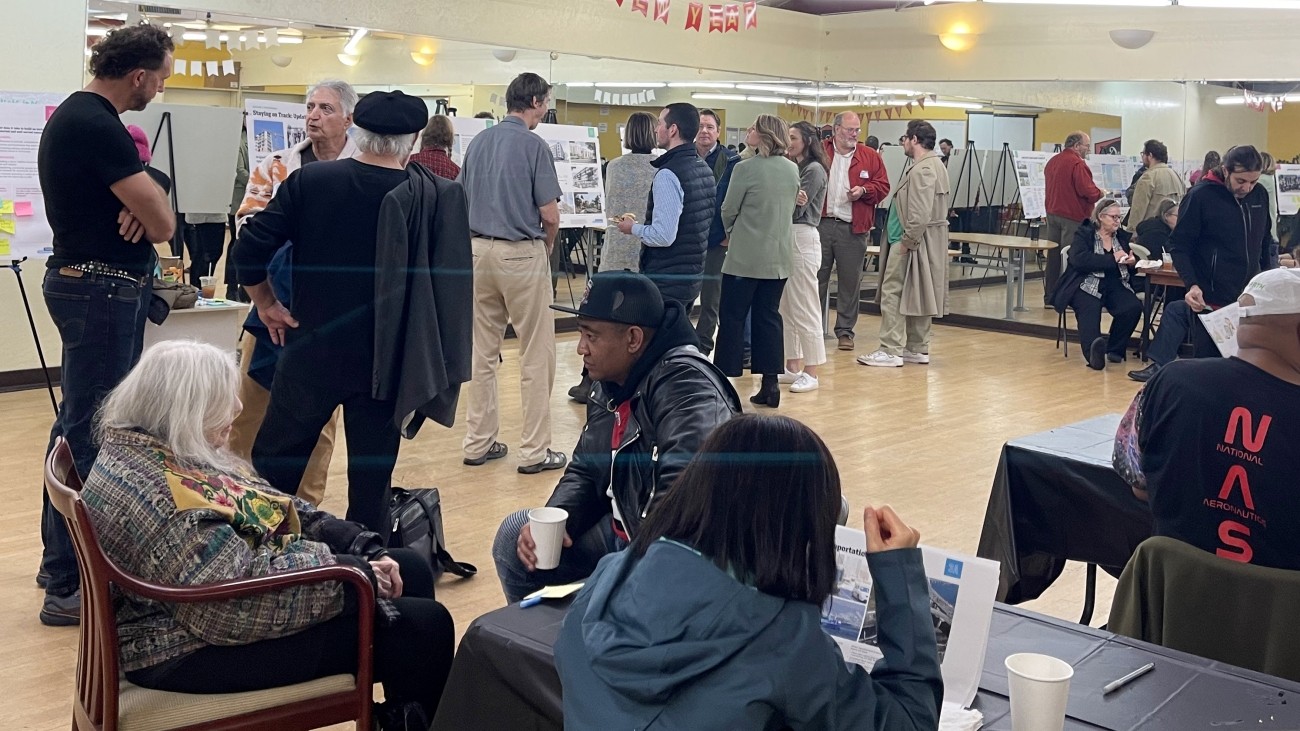
Treasure Island residents attend an Open House at the Ship Shape Community Center on January 20, 2024.
The Transportation Authority is working closely with Treasure Island residents, businesses, community organizations, housing providers, island developers, and the Treasure Island Development Authority on the transportation program.
Use this form for any questions or comments you have about the Treasure Island toll, transit, transit passes or parking policy. (Be sure to leave an email if you'd like a response to your question.)
Recent Past Events
June 11, 2024 Treasure Island Ferry Service Planning Update
At the June 11, 2024 Treasure Island Mobility Management Agency Committee
Treasure Island Ferry Service Planning Update Presentation (PDF)
January 20, 2024 Treasure Island Community Open House
We participated in a community open house hosted by District 6 Supervisor Dorsey, in cooperation with Treasure Island Development Authority, One Treasure Island, Treasure Island Development Group, and a collaboration of City agencies to share information about neighborhood development, transportation updates, and how we are working together to meet the needs of the people that live here today.
July 28, 2022 Public Outreach
Presentation (PDF)
Handout (PDF)
Nov. 17, 2021 Public Outreach
Nov. 17, 2021 Public Outreach presentation (PDF)
Sept. 14, 2021 Treasure Island Outreach for Businesses and Workers
Click here to download the presentation (PDF)
Click here to send us comments or questions about the Sept. 14, 2021 recorded event
April 3, 2021 Treasure Island Community Meeting
Recording of April 3, 2021 community meeting to discuss the Treasure Island toll
Program updates to Board
June 2021: Toll Affordability Program update to TIMMA Committee
January 2020: Program Development and Ferry Service planning update
2022
Treasure Island Mobility Management Program Implementation Report DRAFT (PDF)
Report provides updates to the 2011 Treasure Island Transportation Implementation Plan. Report lays out a transportation program with a series of measures and strategies that will meet the transportation goals of the Redevelopment of former Naval Station Treasure Island.
2021
Approval of toll affordability program for businesses and workers (PDF)
2019
Approval of a toll exemption for current residents of Treasure Island (PDF)
Treasure Island Demand Model Analysis Report For years 2025, 2030, and 2035 (PDF)
Report summarizes results from the 2019 Treasure Island travel demand model for years 2025, 2030, and 2035.
2016
Treasure Island Mobility Management Agency Board Resolution No. 17-03 (PDF)
Resolution approving the Treasure Island Mobility Management Study Toll Policy Recommendations. Includes the Treasure Island Mobility Management Study itself, as well as a memo to the Treasure Island Mobility Management Committee recommending approval.
Treasure Island Mobility Management Study Summary Report (PDF)
A preliminary set of recommendations for the congestion toll aspect of the Treasure Island Mobility Management Program.
2015
Treasure Island Transportation Survey Final Report (PDF)
Overview of key findings from the fall 2014 Treasure Island Transportation Survey.
2014
Economic Development Conveyance Memorandum of Agreement between the Treasure Island Development Agency and US Navy
Establishes the terms, conditions, and schedule governing the transfer of title of the former Naval Station Treasure Island property excluding property to be retained by the U.S. Coast Guard and the U.S. Jobs Corp to TIDA.
Treasure Island Mobility Management Agency Board Resolution No. 110-14 (PDF)
Resolution designating the San Francisco County Transportation Authority as the Treasure Island Mobility Management Agency for certain purposes pursuant to the Treasure Island Transportation Management Act.
2012
Transportation Authority Board Resolution 12-16 (PDF)
Resolution recommending that the Treasure Island Development Authority and San Francisco Board of Supervisors designate the Transportation Authority as the Treasure Island Mobility Management Agency to implement the Treasure Island Transportation Program.
2011
Treasure Island Transportation Implementation Plan (PDF)
Formative plan that identifies key principles, policies, and strategies for the Treasure Island/Yerba Buena Island Transportation Program.
Treasure Island Design for Development
The Design for Development describes the overarching vision, as well as specific design standards and guidelines, that will guide development. The Design for Development implements the Treasure Island/Yerba Buena Island Special Use District of the San Francisco Planning Code. Approved by the Board of Supervisors.
Disposition and Development Agreement
Approved in 2011, the Disposition and Development Agreement governs the developer's ability to develop the project through a series of Major Phases and Sub-phases, as well as the developer's obligations with respect to project elements including public infrastructure, affordable housing, and community benefits.
Final Environmental Impact Report
The Final Environmental Impact Report provides an overview of the environmental impacts related to redevelopment of Treasure Island, as well as the proposed methods for mitigation of these impacts.
Treasure Island/Yerba Buena Island Project: Economic Impact Report (PDF)
The report was prepared by the Office of the Controller.
2008
California Assembly Bill 981
Authorizes pricing program by enacting the Treasure Island Transportation Management Act. Calls for a Treasure Island Mobility Management Agency to manage implementation and operations of the Treasure Island Transportation Implementation Plan for the transportation program on Treasure Island and Yerba Buena Island.

